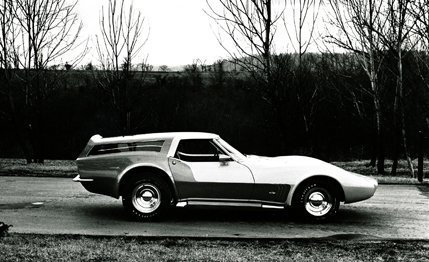If the car receiving surgery is a roadster, the sportwagon top comes as one piece which covers the cockpit and bolts into the normal windshield hardware. If you start with a coupe however, you can retain the lift-out roof panels and the roll bar. In this case the sportwagon back attaches to the existing structure at the stock B-pillars. Once everything is in place, all the seams get fiberglassed, fusing the completed body into one piece and providing a body structure at least as rigid as a stock Vette. Then it is just a matter of normal priming, painting, upholstering and carpeting.
The transformation is dramatic. The new interior space is highly useful. It takes suitcases, groceries, small children and large dogs with no problems. The added space alleviates some of the cloistered feeling one gets when driving a normal Vette, and the added window area and slim B-pillars allow the driver to see much more of what’s going on behind. The weight distribution is left the same, and the car’s total weight is within a few pounds of the stock version, thus the spring rates can remain unaltered. It is doubtful that you could get something into the car that would be heavy enough to cause problems, but air-lifts would be an easy solution for those times you have to carry gold bullion. Even the aerodynamics should be a bit better, with no tunnel roof turbulence to consider. There are just no major drawbacks to the conversion—everything is perfect.
|
|
| |
Almost everything. Problem one is that, on the prototype at least, the exits for the through-air ventilation system have been done away with. Miller now suggests setting the stock grilles in the flange between the fender crown and the rearmost roof pillar. This is probably a satisfactory solution. More serious is the problem of accessibility. Granted, there is a nice big useful space back there—the problem is getting to it. On Miller’s prototype, the only way is over the seats. On the cars made from his kits, the back window will pop out, just like the back window on the coupes. In fact, the hardware will come from Chevy.
This will allow you to get additional air into the cockpit, particularly if you’ve begun with a coupe and can also remove the roof panels, but unless you are loading sliced bread, it will not make the car as practical as it could be. The solution would be to have a lift-up tailgate cut into the back panel, with the seams running down between the taillights. This would solve the problem, but would necessitate a lot of additional bracing and inner panels—besides destroying the visually smooth, hermetic and homogeneous shell of the car.
|
|
The best solution is to be happy with the additional space, and figure that while before you were hassling packages over the front seats, only to discover that they didn’t fit in the standard version’s miniscule trunk, now at least once you get them through the door and into the car, there will be room for them in the back. And that is a definite improvement, reducing the frustration factor to manageable proportions.
Crowd enthusiasm for the car, however, will be hard to keep down to such manageable proportions. We drove the car extensively, and everywhere the car was a star attraction, and that is a pretty big accomplishment for any Vette these days, now that every farmer in Rabbit Hash, Kentucky has at least two. The Corvette has become an everyman’s car in this country, and it takes a really trick example to break through the ennui which surrounds them. The Corvette Sportwagon has penetrating power.
View Photos
View Photos


Leave a Reply